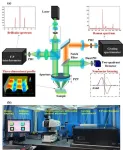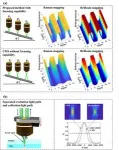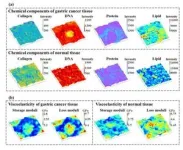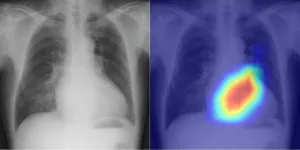There are obvious differences between cancerous cells and normal cells in morphology, chemical properties and mechanical properties. The detection of cytochemical and mechanical properties of tumor tissues can provide multi-dimensional information for the pathological process of cells and human tissues. Among the existing detection methods for the morphology, mechanics and chemical properties of tissue and cells, confocal Raman spectroscopy can detect the chemical properties of micro-regions of samples without contact and label, and confocal Brillouin spectroscopy can detect the mechanical properties of micro-regions of samples without contact and nondestructive. Combining confocal Raman spectroscopy with Brillouin spectroscopy to simultaneously and in-situ detect the three-dimensional morphology, chemical properties and mechanical properties of micro-regions of tissues and even subcellular structures, it is expected to provide a new means for the detection of multi-dimensional pathological information of tissue and cell.
The existing confocal Raman/Brillouin spectroscopic microscopic imaging technology is lack of high precision real-time focusing ability, so that the size of the spot focused on the sample changes with the fluctuation of the sample in the scanning process, thus restricting the realization of the theoretical spatial resolution of confocal spectrum microscopy system. Secondly, due to the weak Raman and Brillouin scattering spectra and long integration time, confocal spectrum microscope is easy to be affected by system drift and lead to defocus, thus affecting the spatial resolution and imaging quality. In addition, when it was used for biological tissue slice samples imaging, the fluorescence signal generated by vertical incidence will reduce the signal-to-noise ratio of the sample's Raman spectrum, thus affecting the accuracy of Raman spectrum and Brillouin spectrum detection and reducing the detection accuracy.
Therefore, in a new paper published in Light Science & Application, a team of scientists, led by Professor Weiqian Zhao from Beijing Institute of Technology proposed a new divided-aperture laser differential confocal Raman-Brillouin spectrum microscopy (DLDCRBSM) with high-stability, high-resolution, anti-scattering capability as shown in Figure 1(a), which has one Grant Chinese invention patents (ZL 201410086366.5) and one Grant European invention patents (EP 3118608 B1). Combining divided-aperture laser differential confocal microscopy with Raman spectroscopy and Brillouin spectroscopy, it used the differential confocal microscopy to achieve the nanometer-precision focusing of the sample and improve the spatial resolution and stability, used divided-aperture technology to effectively suppress the interference of the stray light of the defocus layer and the reflected lights to improve the signal-to-noise ratio, and it used the co-axial exciting and high resolution separate detection to achieve the high-stability and high-spatial-resolution spectrum simultaneous imaging for the geometrical topography, Raman and Brillion spectrum from the same region.
Based on the proposed method, the divided-aperture differential confocal Raman-Brillouin spectrum microscope with high spatial resolution and 3D imaging focusing and tracking ability is developed, as shown in Figure 1(b). It has an axial focusing accuracy of 1nm, a spectral image lateral resolution of better than 400nm, a Raman spectrum detection resolution of 0.7cm-1 and a Brillouin spectrum detection resolution of 0.5GHz.
The established microscope was used for a strip-shaped polymethyl methacrylate (PMMA) sample on Si substrate, and obtained the clear images of sample due to its axial real-time focusing, shown in Figure 2(a). Therefore, it verified the proposed method has the anti-drift capability. The established microscope was used for the double-layer transparent sample with the upper layer of PMMA and the lower layer of SiO2, and the measurements is shown in Figure 2(b). Figure 2(b) indicates that established microscope has the ability of suppressing the interference of defocused stray light.
Raman and Brillouin mapping of gastric cancer tissues and adjacent normal tissues was carried out by using the developed differential confocal spectroscopy microscope. The results confirmed the previous hypothesis that the changes of protein substances in cancer tissues and the changes of tissue viscoelasticity lead to the increase of invasiveness.
Figure 3(a) shows the chemical imaging results of gastric cancer tissues and its adjacent normal tissues by this differential confocal spectroscopy microscope, and the concentration is characterized by the intensity of the characteristic peak of Raman spectra. Compared with the adjacent normal tissues, the concentration of collagen in gastric cancer tissues was low and the distribution was discrete. The concentration of DNA material in gastric cancer cells is high and the distribution range is wide. The protein concentration in the cell matrix of gastric cancer tissues was low. The lipid concentration in gastric cancer tissue is high within the matrix, while the lipid distribution in normal tissue is relatively uniform.
Figure 3(b) shows the imaging results of mechanical properties of the gastric cancer tissue and adjacent normal tissues by the differential confocal spectroscopy microscope. The frequency shift of Brillouin spectrum represents the energy storage modulus (i.e. elasticity) of a substance, while the full width at half maximum of Brillouin spectrum represents the loss modulus (i.e. viscosity) of a substance. Compared with the mechanical imaging results of adjacent normal tissues, the elasticity of gastric cancer cells and intercellular substance was lower, and the elasticity of cancer cell nucleus was higher. The stickiness of gastric cancer cells and interstitial t issue was lower, and the stickiness of cancer cell nucleus was higher.
In this study, a laser differential confocal Raman-Brillouin spectroscopy imaging method with high stability, high resolution and anti-scattering was proposed, and the corresponding instrument was successfully developed to detect the three-dimensional morphology, mechanical properties and multi-dimensional information of the samples, and was used in the characterization analysis of tumor tissues to verify its application. This method can provide a new method for the research of cancer process and cancer treatment.
END







